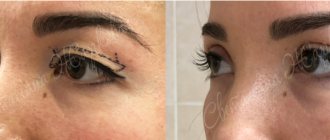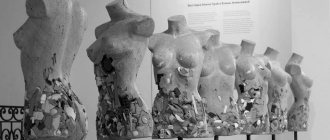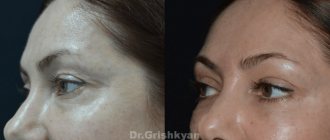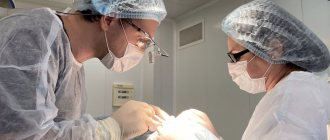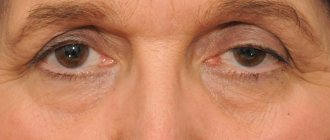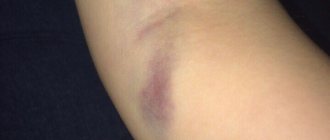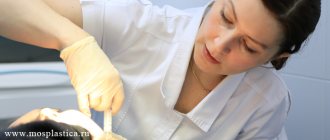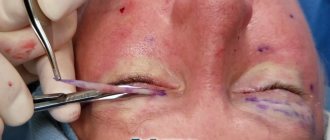Swelling after blepharoplasty and features of the postoperative period
All patients are concerned about significant swelling after blepharoplasty.
You should know that swelling is a normal reaction of the body to tissue damage and should not be a cause for concern. A cooling bandage and compresses help reduce swelling. Limiting physical activity and taking anti-inflammatory drugs also help speed recovery. Bruising after blepharoplasty is another inevitable consequence of plastic surgery. Hematomas do not require special treatment and go away on their own within two weeks. Approximately the same amount of time is needed for the complete disappearance of tissue edema, but the change in skin color in the periorbital area can last up to 3-4 weeks. But from about the tenth day you can already use decorative cosmetics, which help hide the marks of plastic surgery.
After blepharoplasty, patients complain of discomfort and a feeling of stiffness in the eyelid area. These symptoms do not require special treatment; it is enough to follow general recommendations. Pain in the eyes, increased sensitivity to light, dry eyes or watery eyes, and temporary changes in vision also often accompany blepharoplasty.
Antiseptic eye drops help moisturize the mucous membrane and prevent infectious complications. During the daytime outdoors, it is advisable to wear sunglasses or glasses with tinted lenses. It is necessary to regularly perform gymnastics for the extraocular muscles and the orbicularis oculi muscle.
You will have to give up contact lenses for a couple of months and return to regular glasses. For 2-3 weeks you need to limit physical activity. If possible, you should sleep on high pillows. During the entire recovery period, you should not visit the solarium or sauna. It is advisable to give up alcohol, coffee and smoking. You should not take medications without first consulting your doctor.
The exact recovery time depends on many factors: the method and extent of surgical correction, the patient’s age, the condition of the skin and soft tissues of the face and periorbital area.
Physiotherapeutic methods can speed up tissue regeneration. In our clinic, microcurrent therapy is actively used after eyelid surgery. Each patient after plastic surgery is provided with three free procedures. The results of blepharoplasty can be assessed after 2 months.
Late complications after eyelid surgery
Some problems after surgery may appear after the rehabilitation period is over:
These include:
- Visible asymmetry of the eyes (appears due to uneven stitches or improper scarring)
- Dehiscence of seams (if not corrected, a rough scar will form)
- Dry keraconjunctivitis (eliminates with special drug treatment)
- The effect of “weathering of the eyes” (this is when the eyelids do not close completely)
- Tearing (caused by improper scarring or edema)
- Blepharoptosis
Most of the undesirable consequences listed above are extremely rare . And can be eliminated by repeated surgery. To minimize the risk, it is important to find a plastic surgeon with extensive experience, carefully consider the process of preparing for surgery and follow the doctor’s recommendations during rehabilitation .
Sutures after blepharoplasty
Sutures after blepharoplasty are not always applied; for example, with transconjunctival access, a cooling bandage and a patch on the eyelids are sufficient. Thanks to the excellent blood supply to the conjunctiva, the wound heals on its own in the shortest possible time.
If the surgical approach is through skin folds or along the ciliated edge of the eyelid, absorbable suture material is used. Minor scars remain after any operation, but after blepharoplasty they are not visible because they follow natural folds.
Functional complications of blepharoplasty
After blepharoplasty, the manifestation of the so-called “dry eye syndrome” may be observed - its signs may be a decrease in tear production, a feeling of dryness and burning of the eyes. This complication usually develops in people who, even before surgery, suffered from insufficient tear production. If dry eyes are caused by incorrect position of the lower eyelid after surgery, then canthopexy is performed for correction.
Often the opposite manifestation can occur - excessive tearing of the eyes, caused by increased irritation of the lacrimal gland. After the sutures are removed, the manifestations of this complication go away on their own.
Incomplete closure of the palpebral fissure, called lagophthalmos, may be normal in the early postoperative period, but prolonged persistence indicates excessive excision of eyelid tissue. Depending on the degree of manifestation of the complication, drug therapy may be prescribed - to stretch the skin of the eyelids or repeated blepharoplasty. If the tension in the lower eyelid is too great, perhaps because a lot of skin has been removed, the outer corners of the eye may droop, giving the patient a “sad” appearance. If initially the tissue tone of the lower eyelid was sharply reduced or a lot of skin was removed from the lower eyelid, then it may be pulled down excessively - this condition is called ectropion . This complication of blepharoplasty most often resolves on its own within some time after the operation. If complications persist, canthopexy is performed.
The occurrence of ectropion of the lower eyelid with a correctly performed surgical technique is extremely rare.
When is it necessary to visit a doctor?
You should consult a surgeon when complications after blepharoplasty surgery on the upper or lower eyelids interfere with a normal lifestyle. For example, the eye does not close completely or is excessively dry - this may be the result of some problem that has arisen due to surgery.
In general, any changes in appearance or physical well-being that concern you should be a reason to visit a surgeon. This could be any visible defect at the operated site, or, for example, an increase in body temperature or nausea. A timely diagnosis and surgical treatment will help reduce to zero the risks of possible complications after eyelid blepharoplasty.
Following your doctor's recommendations is an important step towards a beautiful look.
How to reduce the risk?
To minimize the risks of complications after blepharoplasty surgery, it is necessary to follow the prohibitions and rules for eyelid skin care. This is a ban on visiting a bathhouse, sauna, beach, solarium, swimming pool, limiting sports activities, sleeping in a semi-sitting position, and much more. Of course, all of these are purely temporary measures. After completion of rehabilitation, the patient will be able to return to a normal lifestyle.
It is also necessary to lubricate the operated area with drugs that promote the resorption of hematomas and swelling. Take antibiotics as prescribed by your doctor. Under no circumstances should you prescribe treatment for yourself, much less medical supplies, on your own! This can only provoke complications after blepharoplasty.
Reasons for appearance
As a rule, there are three groups of reasons that cause complications after blepharoplasty of the upper or lower eyelids:
- medical errors,
- ignoring doctor's orders in the postoperative period,
- individual factors.
The two groups are based on human factors. A surgeon’s mistake can happen if the patient entrusts his health to an inexperienced or even unqualified doctor. If the patient himself is not determined to follow the recommendations of his doctor and properly care for the skin of the eyelids after the intervention, then the result of the operation may be far from desired.
Individual factors that cause complications after eyelid blepharoplasty are, for example, an increased tendency to form scar tissue, allergic reactions, abnormal location of the vascular network under the eyes, etc. Most of these factors are excluded at the stage of consultation with a surgeon and a full examination, without which it is impossible to obtain admission to surgery.
Type 2. Functional risks and potential complications
These risks are related to the functions of the eyelids and eyes (blinking, vision, tear ducts). When too much skin tissue is removed, there is an increased risk that patients will have trouble closing their eyes completely, especially while sleeping.
The photo shows a patient who came to the clinic after blepharoplasty, which caused both functional and aesthetic complications.
The suture of the upper eyelid was made high, a large skin flap was excised, and during plastic surgery of the lower eyelids, hernias were removed, which led to pronounced depressions and drooping of the lower eyelid. This complication can lead to dry eyes and frequent irritation and discomfort, as well as the need for frequent use of a moisturizing eye solution.
Rehabilitation period by day
1 day. The patient is discharged from the clinic after the operation. On this day, the eyes are most sensitive to light, so it is recommended to have dark glasses with you to put on before going outside. By evening, swelling increases. Possible lacrimation, dry eyes, blurred vision.
To reduce pain, your doctor may prescribe analgesics. Any medications (drops, ointments) should be used only as prescribed by a doctor. It is necessary to remain calm and avoid any strain on the eyes. You need to sleep on your back, with your head elevated, to improve the flow of fluid from the upper body and reduce swelling.
2-3 days. Painful sensations decrease, swelling, on the contrary, increases, reaching a maximum on the 3rd day. It is acceptable to use a cold compress on the eyes - apply an ice pack wrapped in several layers of clean, dry cloth to the operated area. There may be numbness and impaired sensitivity of the skin in the surgical area.
These days you can already wash your face and hair, trying not to wet the skin of your eyelids. As before, you should try not to strain your eyesight, devote a minimum of time to reading, watching TV, and working at the computer. The patient must continue to follow all the doctor’s prescriptions - drops, treatment of sutures if necessary.
3-5 days. Symptoms persist or improve slightly.
5-7 day . Usually on the 5th day a follow-up examination is scheduled in the clinic, the surgeon removes the sutures (if self-absorbable threads were not used). There may be redness and slight swelling in the area of the sutures.
7-10 days. Symptoms gradually decrease, and by day 10 the patient can return to normal life with some restrictions on eye strain. After 10-14 days you can wear contact lenses.
The final result of the operation can be assessed after 1-2 months. By this time, the epidermis of the skin of the eyelids is renewed, the seams become unnoticeable. After six months, postoperative scars are almost impossible to detect; they look like a thin strip in the crease of the upper eyelid or along the lower edge of the eyelashes.
Is blepharoplasty dangerous?
Blepharoplasty is a plastic surgery, so it must be performed by a highly qualified surgeon. The eyelid area and area around the eyes is a sensitive area with thin skin.
Many people who have indications for eyelid correction are afraid to have surgery because they believe in myths. For example, there is a fear that blepharoplasty will lead to worsening vision. However, doctors say the opposite. Temporary deterioration is possible due to swelling of the eyelids, but as the swelling goes away (2-3 days), vision will improve.
Sutures and marks from them also frighten patients. There is nothing to be afraid of here either, since the seam is made in the crease of the eyelid, which makes it as invisible as possible. Thin incisions also minimize surgical scars.
The patient can return to his normal lifestyle within 2 weeks after the correction.
Lower blepharoplasty
Agreement for the processing of personal data
Attention! For reasons of economic, organizational, and sometimes legal nature, the Agreement is subject to periodic changes. The Site Administration does not have the ability to send Users notifications about such changes, so we urge you to periodically visit this page to check if anything has appeared here that contradicts your beliefs and principles.
If you, as a User, do not agree with the changes made, you always have the right to refuse access to the Site and stop using its materials.
If you believe that the Agreement or the actions of us as the Site Administration violates your rights, do not remain silent, write to us about it by email
1. Terms used in this Agreement:
1.1. A website is a collection of texts, graphic elements, design, images, program code, photo and video materials and other results of intellectual activity contained on the Internet under the domain name vasilev.pro
1.2. The Site Administration is a person who has the rights to administer the Site.
1.3. User is any person who has logged into the Site and accepted the terms of this Agreement.
2. Use of personal data
2.1. By accepting the terms of this Agreement, the User gives his consent to the Site Administration to collect, store and process his personal data specified by filling out web forms on the website vasilev.pro and its subdomains *.vasilev.pro (hereinafter referred to as the Site). Personal data means any information relating directly or indirectly to a specific or identifiable individual (citizen).
2.2. Purposes of processing personal data:
2.2.1. Party identification.
2.2.2. Providing the User with personalized offers and execution of agreements and contracts.
2.2.3. Communication with the User, including sending notifications, requests and information, as well as processing requests from the User.
2.2.4. Improving the quality of the site, services and services provided by the Site Administration, developing new services.
2.2.5. Conducting statistical and other studies based on anonymized data.
2.2.6. The user also gives his consent to the processing and cross-border transfer of personal data to the Company's contractor for sending marketing and informational mailings.
2.3. The following personal data is subject to processing:
2.3.1. Last name, first name, patronymic of the User;
2.3.2. User's email address;
2.3.3. User's phone number.
2.4. Processing of personal data means the following list of actions with personal data: collection, recording, systematization, accumulation, storage, clarification (updating, changing), extraction, use, transfer (distribution, providing access), depersonalization, blocking, deletion, destruction of personal data - all mentioned actions are only for the purposes specified in clause 2 of this Agreement..
2.5. The Site Administration undertakes not to transfer information received from the User to third parties. It is not considered a violation to provide personal data to third parties acting on the basis of an agreement with the Site Administration to fulfill obligations to the User and only within the framework of this Agreement.
2.6. Personal data is stored and processed until all necessary procedures are completed or until the Site is liquidated
2.7. This consent to the processing of personal data is valid indefinitely, but can be revoked by the subject of personal data on the basis of a personal statement sent by email to the Site Administration.
2.8. The Site Administration undertakes to use the User’s personal data obtained as a result of using the Site in accordance with the requirements of the law: Article 24 of the Constitution of the Russian Federation and Article 6 of the Federal Law on the Protection of Personal Data, including Federal Law No. 152-FZ of July 27, 2006 “On Personal Data” » as amended at the time of processing of such personal data.
3. The user accepts the cookie policy used on the Site and agrees to receive information about the IP address and other information about his activity on the Site. This information is not used to identify the User.
4. When processing personal data, the Site Administration takes necessary and sufficient organizational and technical measures to protect personal data from unauthorized access to it, as well as from other unlawful actions in relation to personal data.
